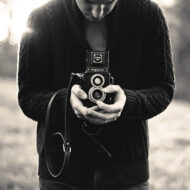Stepping Back From the Canvas
Seeing Your Work Clearly Through Other Perspectives
Stepping back from the canvas. What does that even mean and why would anyone do it?

Being too close to your work for too long can create a type of tunnel vision.
A strange thing happens when artists work so closely with a piece. Over time we can get a type of what I call tunnel vision. Somehow certain things become invisible or blurry, almost as if they were on the periphery of that narrow tunnel where we can see clearly. Sometimes things like balance, perspective, contrast, color balance, etc. can be off just slightly enough that we can’t see it. There’s a good reason for this. Our strongest, clearest vision happens in the center of your eyes. Anything in your peripheral vision is not in focus. Your physical proximity to your canvas can often leave most of your work in your peripheral vision.
Also, we can become so vested in a piece that we can no longer tell what needs to be corrected. It’s understandable. That notorious drive for perfection. This is your baby and it’s beautiful, and perfect, and so adorable! There’s absolutely nothing wrong with it. Or maybe you do realize that something’s off, but you can’t quite put your finger on it. If you’re like me and have very few artistic friends who live in your area to go to for a reliable or knowledgeable opinion, what do you do? Here are my three best tips for seeing your work through a different pair of eyes (sort of)…
- Step Away From It. Stepping back from the canvas is a method master artists used way back when and it’s still a popular method today. When we’re working on a piece, we’re usually right on top of it. Sometimes less than a foot of space between our eyes and the surface of the canvas. Take five to ten steps away from it and study it from a distance. Then maybe take another five to ten steps.

Step back. Allow your eyes to relax and view your work in its entirety.
Pulling back from it and viewing it from a distance allows your eyes to relax and take in the whole composition at once in its entirety rather than viewing it from a more microscopic view point. Extremely close proximity makes it difficult for the mind to properly discern color balance, overall balance of the composition, contrast, perspective, etc. Stepping back allows the mind to process the piece as a whole and for these elements to work together as they should.
- Take a Photo of It. I started using this one most often because of social media. It was actually an accidental discovery. The moment I started posting progress photos of my work, I started noticing things in the photos that I couldn’t see as I was working. A tiger portrait that I’m currently working on for example, has a background of jungle foliage. Up close and personal, it looked fine. But in the photos, I started noticing repeating patterns of leaves and an overall flatness of this area.

Use your smart phone to take photo of your work! You may be surprised what pops up.
The photo helped me to see areas where I could blur out some clusters of leaves, add more graphite to others to make them seem farther back in the brush, and darken some areas altogether to give it added depth. For some reason, it wasn’t as obvious just looking at it directly with my eyes.
- Use a Mirror. Seeing your work in reverse often times reveals things, too. You will see graphic artists use this technique quite a bit. They’ll flip the image and make adjustments. They’ll do this throughout the entire process, constantly flipping the image back and forth.

Using a mirror to view a reverse image of your work can reveal quite a bit.
If you’re not a graphic artist and it’s difficult for you to get a big enough mirror to your work, maybe you can use the photo method and flip that instead.
Are you an artist who makes it a habit of regularly stepping back from the canvas? Do you use any of the other methods? Or do you have another method that works well for you? Leave a comment below and let us know.
This blog contains Amazon Affiliate links. As an Amazon Associate, I may earn from qualifying purchases.


Recent Comments